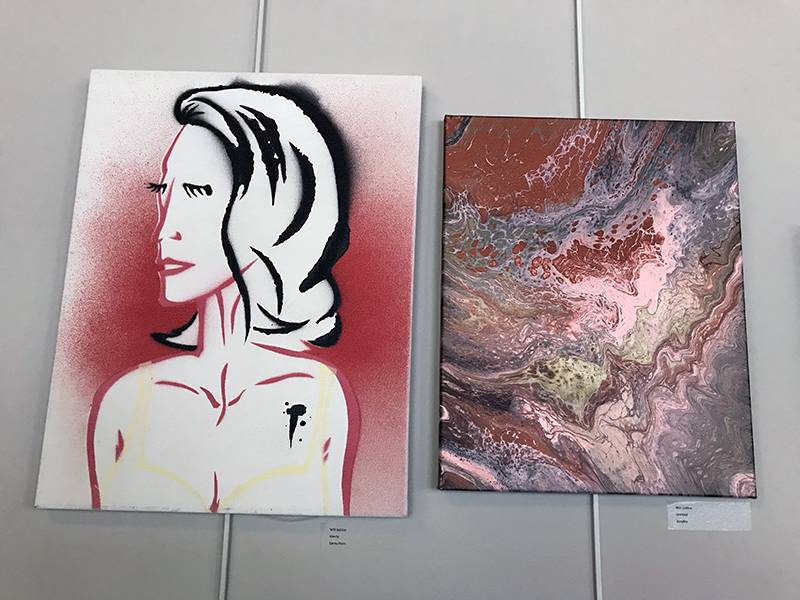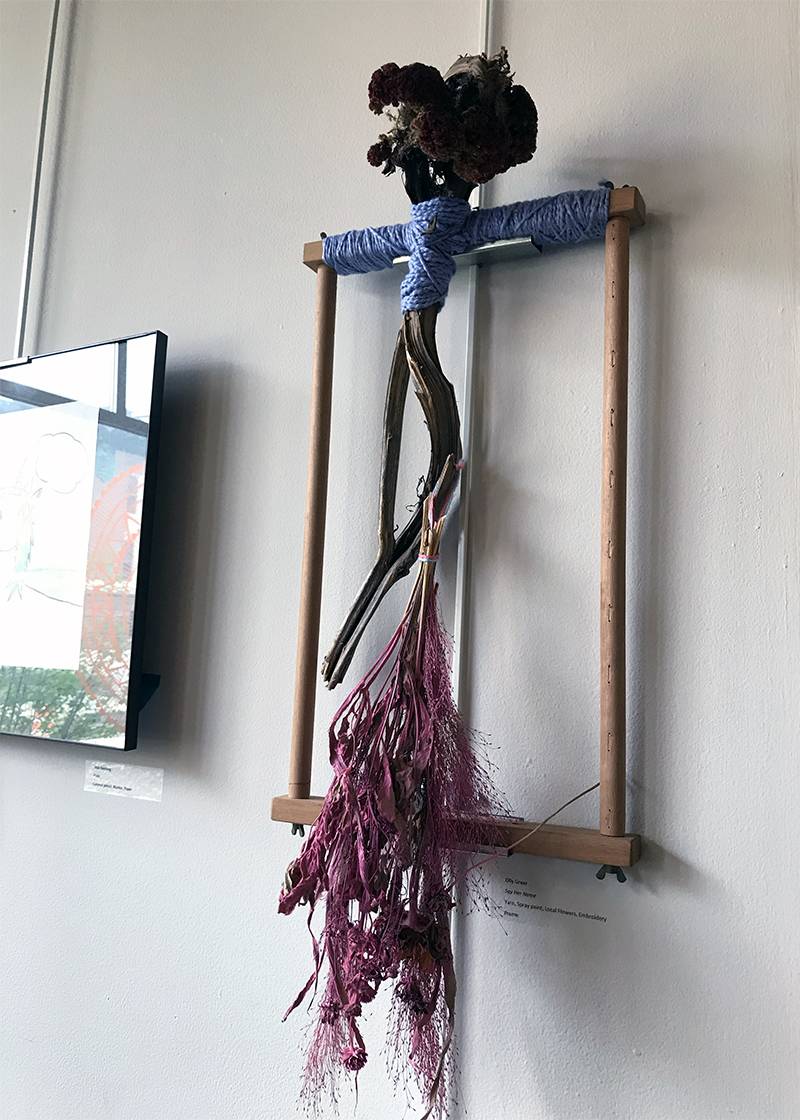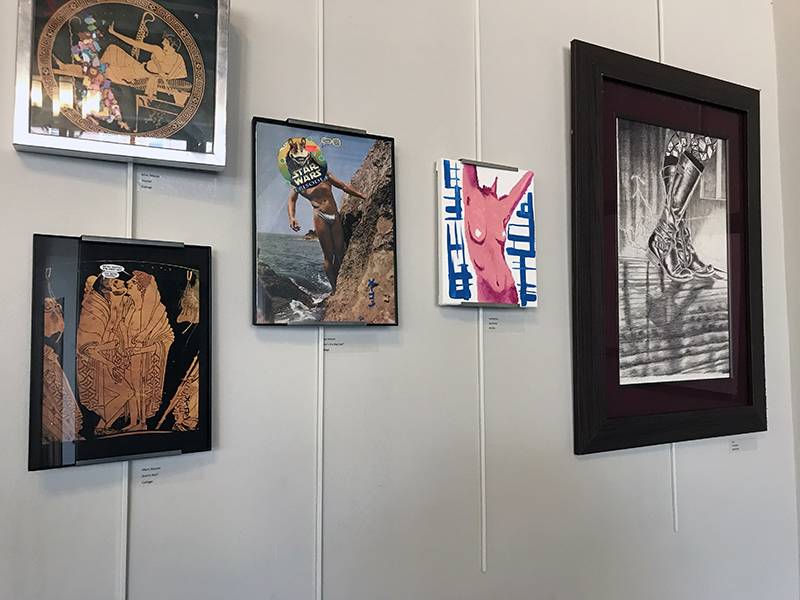Sometimes, if you’re lucky, an art event takes hold of your imagination, lingers in your brain and your heart till you find yourself exploding with thoughts, feelings, and questions. And over time, as you live with it, talk about, and talk about it some more, it haunts you, lovingly but insistently nonetheless. And if you happen to be a local arts writer, you find yourself dreaming up copy about it, framing arguments in the shower, until you have no choice but to write about it. I am that writer, and Queering UP the Arts, the recent exhibition at the University’s Murphy Gallery is that event.
Shortly after the event came onto my radar, I wrote up a SPlog about it, and, just last week, I urged you to see it before it closed on May 13th. Throughout the exhibit’s run I talked to several of the artists who participated. Doing so convinced me that my instincts were right. What I had to say would best be said in an op ed-essay-interview hybrid, rather than a traditional review. So here I go, queering up the Smile Politely arts section.
But first, a few important caveats.
One. This is an opinion. You are free to disagree. You are more than welcome to disagree. That’s what discourse is for.
Two. We’ll be covering some big questions, most of which ultimately deserve more space than I can provide here. But it is a place to start.
Three. I fancy myself thoughtful and sensitive, but I am not perfect. Nor have I spent the majority of my life in this community. So if I miss something, or mistep, know that this piece is inspired by love for art and artists and everything they experience.
The notion of a queer art show, or space, can be complex and controversial. As we’ll see in a minute, there are many things queer arts shows and spaces are, but here is one thing they are not. They are not merely collections of work by “gay” artists.
In its statement for Queering UP the Arts, the University Y expressed its excitement “to be collaborating with the UP Center to celebrate queer artists and artworks.” The semantics are important here. Queer is a diverse range of identities and identity expressions. It is not monolithic, and no exhibition of queer art and artists, deserves to be reduced or oversimplifed.
Queering as verb is a call to disrupt, to complicate, and to undermine assumptions. It is the smashing up of identity checkboxes and mainstream labels. It is the power to reclaim and rename. In the hands of an artist, the revolutionary weapon may be a camera, a paintbrush, digital media or nontraditional media.

(Paintings by artist Will Justice)
This bring us to the fundamental questions of what is the purpose of art, and, similarly, what is the role of the artist. Art can do many things, big or small. One artist may enjoy the fact that they created a piece that makes its owner smile every day. That’s fine. But that’s not every artist’s goal. And that’s fine too.
The University Y and the UP Center see a deeper potential in the creation of art. And so do I. They launched this exhibit with the belief that “the visual arts have served as a means of expression, politic, protest, and connection especially for individuals who identify as LGBTQ+. The UP Center and the University Y are excited to celebrate the queer art-makers in our region as they carry the proverbial torch.”
The University Y is in many ways a perfect space for an exhibit this. It is free and open to the public, it is by mission dedicated to “social justice through quality arts programming.” As a part of the University Campus, and as a gallery/lounge where students, faculty, and community members gather, it held a space for the quiet power of this exhibit to slowly make its impact, perhaps even by osmosis. For queer students, especially those who are struggling against rejection, bullying or worse, I like to imagine that this space, this exhibit, gave them hope, and perhaps even inspiration.
Some may wonder why queer artists would want to show in this way (as opposed to be included in a “regular” show or “fully-inclusive” show). Some may even argue that shows like this only serve to further “ghettoize” the artists. There are a lot of assumptions to unpack here, but I’ll start with the issue of community.
I myself have been guilty of relying on the phrase “our local arts community” as if it were one happy, blended family. But it’s more complicated than that.
Queer maker Olly Greer was disappointed by the lack of queer bars and spaces when they first came to the Champaign-Urbana area. All artists struggle to find their voice and to be heard. For queer and trans artists this struggle is greatly magnified. For queer and trans artists, as Greer reminded me, the struggle is continuous and often unrelenting. There is a continual struggle to be seen and to be called by the correct name and pronouns. Greer credited the University Y and the UP Center, which though Campus-related are public spaces, for demonstrating such support and openness. Openness to queer and trans artists and makers like themselves whose powerfully provocative work (see below) employs nontraditional materials and methods.

Along with Olly Greer, Marc-Anthony Macon reminded me how important spaces like the one this show created are for the artists themselves and for the community. In spaces like Queering UP the Arts, queer artists experience a greater sense of safety in taking risks, both with message and media.
Especially for such a small community, I have been invigorated and inspired by the sheer amount of raw queer talent in Champaign-Urbana. Art lovers in big cities have grown accustomed to seeing a cavalcade of work from queer artists, but most towns of this size don’t have that luxury. We’re very lucky to have the comfort of a small town in tandem with platforms through which radicals and LGBTQ folks can express their ideas, compare notes, and put their hearts out there for the edification of everyone. I was honored to be among the artists selected to exhibit at Queering Up the Arts, but far more ecstatic to see the work of so many of my fellow local queers. The exhibit was at once heart-warming, challenging, vibrant, dark, hopeful, and grounded. It was a distinct pleasure to have my work hang next to so many artists that I admire, and I hope this kind of event will continue to be a regular and expanding part of our community’s aesthetic, political, and social landscape.
—Marc-Anthony Macon

Queering UP the Arts as a concept (rather than an exhibit) destablizes our notion of what queer subject matter is. Queer artists may not feel ready or able to tackle more challenging subject matter when shown with straight, cis-genered artists. Or they may. Or maybe they have a different story to tell. That’s their choice. The important thing is that we as viewers allow ourselves to see through someone else’s eyes and heart.
I commend the University Y and the UP Center for Queering UP the Arts. You wouldn’t be reading this story without it. They did it right, even in making the show inclusive of students and local artists of all ages from throughout the central Illinois area.
So let’s follow their lead. Let’s keep the torch burning. Curators, artists, art fans, let’s find ways to hold queer spaces both in public spaces and community spaces. I’ll do my part by keeing this space safe and welcoming.
Art can expose what’s hidden. It can take the invisible and make it visible. Now more than ever, we need to listen to people who feel silenced. When you get a chance to experience exhibits like Queering UP the Arts, don’t miss it. Don’t stay home because it’s not for you. It’s your chance to listen, learn, appreciate, and perhaps even be transformed. The best part of curating visibility is that it creates empathy. And we need more of that right about now.
Perhaps it is a just a happy accident (or not) that I publish this piece today, May 16th, on “Honor Our LBGT Elders Day”. Or, that it follows the recent 50th anniversary of the Stonewall Riots and comes in time to welcome in Pride Month in June.
Photos from Debra Domal








